
- school Campus Bookshelves
- menu_book Bookshelves
- perm_media Learning Objects
- login Login
- how_to_reg Request Instructor Account
- hub Instructor Commons
- Download Page (PDF)
- Download Full Book (PDF)
- Periodic Table
- Physics Constants
- Scientific Calculator
- Reference & Cite
- Tools expand_more
- Readability
selected template will load here
This action is not available.


6.3: Homework
- Last updated
- Save as PDF
- Page ID 70322

- Julie Harland
- MiraCosta College
- Submit homework separately from this workbook and staple all pages together. (One staple for the entire submission of all the unit homework)
- Start a new module on the front side of a new page and write the module number on the top center of the page.
- Answers without supporting work will receive no credit.
- Some solutions are given in the solutions manual.
- You may work with classmates but do your own work.
How would you explain to someone what the "absolute value of a number" means? Explain without using examples.
Simplify each of the following:
Write any and all numerals that have the given absolute value:
For each vector drawn, write the number that the vector represents:

Look again at the four vectors shown in exercise 4. If someone had drawn those vectors to find the difference of two numbers using the missing addend approach, write the four subtraction problems which generated those vectors.
Use vectors on the number line to add -8 + 5 + (-3) using vectors as actions. Mark and LABEL your number line with at least zero and a point on either side. Explain how to read the answer.

-8 + 5 + -3 = _____ since ______________________________________________
Use vectors on the number line to compute the 8 – 5 + -7 – -4 using vectors to DO and UNDO actions. Mark and LABEL your number line with at least zero and a point on either side. Explain how to read the answer.

______________________________________________8 – 5 + -7 – -4 = _____ since ______________________________________________.
Use the missing addend approach to perform the following subtractions. Label the vector on the number line.
Use red and green counters to add the following integers. For each problem, explain and show each of the steps involved.
For each problem, use positive and negative counters. First, state what the problem means, and then explain and show each step you need to take to find the answer. Each problem requires 3 or 4 steps.
For each of the following sets, determine if the set is closed under the operation given. Provide a counterexample if it is not closed.
Use your counters to do each of the following multiplication problems using the definition of multiplying two integers with positive and negative counters. Then, explain what the multiplication problem given means in terms of the counters, and explain and show each of the individual steps.
- Texas Go Math
- Big Ideas Math
- enVision Math
- EngageNY Math
- McGraw Hill My Math
- 180 Days of Math
- Math in Focus Answer Key
- Math Expressions Answer Key
- Privacy Policy

Texas Go Math Grade 5 Lesson 6.3 Answer Key Fraction and Whole-Number Multiplication
Refer to our Texas Go Math Grade 5 Answer Key Pdf to score good marks in the exams. Test yourself by practicing the problems from Texas Go Math Grade 5 Lesson 6.3 Answer Key Fraction and Whole-Number Multiplication.
Unlock the Problem
Charlene has five 1-pound bags of different color sands. For an art project, she will use \(\frac{3}{8}\) pound of each bag of sand to create a colorful sand-art jar. How much sand will be in Charlene’s sand-art jar?
- How much sand is in each bag? ____________________
- Will Charlene use all of the sand in each bag? Explain. ____________________
Multiply a fraction by a whole number.

- How much sand is in each bag? 1 pound
- Will Charlene use all of the sand in each bag? Explain. No, she will use 3/8 pound of the sand in each bag.

Explain how you can find how much sand Charlene has left. Answer:

Share and Show
Find the product. Write the product in simplest form.

- Multiply the numerator by the whole number. Write the product over the denominator.
- Write the answer as a mixed number in simplest form.

Question 5. The caterer wants to have enough turkey to feed 24 people. If he wants to provide \(\frac{3}{4}\) of a pound of turkey for each person, how much turkey does he need? (A) 72 pounds (B) 24 pounds (C) 18 pounds (D) 6 pounds
a. What do you need to find? Answer: He need to find that how much turkey he needs .
b. What operation will you use? Answer: He uses Multiplication operation.
c. What information are you given? Answer: The information given is 24 people . 3/4 of a pound person.
d. Solve the problem. Answer: 24 x (3/4) = 72/4 = 18
e. Complete the sentences. The caterer wants to serve 24 people __________ of a pound of turkey each. He will need ________ × ________, or ________ pounds of turkey. Answer: The caterer wants to serve 24 people 3/4 of a pound of turkey each. He will need 24 ×3/4 , or 72/4 or 18 pounds of turkey.

H.O.T. Algebra Find the unknown digit.

Daily Assessment Task
Fill in the bubble completely to show your answer.

Texas Test Prep

Texas Go Math Grade 5 Lesson 6.3 Homework and Practice Answer Key
Find the product. Write the product in the simplest form.
Question 1. \(\frac{3}{7}\) × 4 = ____________ Answer: (3/7) x 4 = (3 x 4)/7 = 12/7 The product is 12/7 . The simplest form of 12/7 is 1(5/7) . Explanation: In the above image we can observe the expression (3/7) x 4. First multiply the two whole numbers in the numerator. Multiply 3 with 4 the product is 12. Write the product 12 over the denominator 7. Write the fraction 12/7 in simplest form as a mixed number. The mixed number is 1(5/7).
Go Math Lesson 6.3 5th Grade Answer Key Question 2. \(\frac{3}{5}\) × 5 = ____________ Answer: (3/5) x 5 = (3 x 5)/5 = 15/5 The product is 15/5 . The simplest form of 15/5 is 3 . Explanation: In the above image we can observe the expression (3/5) x 5. First multiply the two whole numbers in the numerator. Multiply 3 with 5 the product is 15. Write the product 15 over the denominator 5. Write the fraction 15/5 in simplest form as 3.
Question 3. \(\frac{2}{3}\) × 8 = ____________ Answer: (2/3) x 8 = (2 x 8)/3 = 16/3 The product is 16/3 . The simplest form of 16/3 is 5(1/3) . Explanation: In the above image we can observe the expression (2/3) x 8. First multiply the two whole numbers in the numerator. Multiply 2 with 8 the product is 16. Write the product 16 over the denominator 3. Write the fraction 16/3 in simplest form as a mixed number. The mixed number is 5(1/3).
Question 4. 16 × \(\frac{3}{4}\) = ____________ Answer: 16 x (3/4) = (16 x 3)/4 = 48/4 The product is 48/4 . The simplest form of 48/4 is 12 . Explanation: In the above image we can observe the expression 16 x (3/4). First multiply the two whole numbers in the numerator. Multiply 16 with 3 the product is 48. Write the product 48 over the denominator 4. Write the fraction 48/4 in simplest form as a 12.
Question 5. 9 × \(\frac{5}{6}\) = ____________ Answer: 9 x (5/6) = (9 x 5)/6 = 45/6 The product is 45/6 . The simplest form of 45/6 is 7(3/6) . Explanation: In the above image we can observe the expression 9 x (5/6). First multiply the two whole numbers in the numerator. Multiply 9 with 5 the product is 45. Write the product 45 over the denominator 6. Write the fraction 45/6 in simplest form as a mixed number. The mixed number is 7(3/6).
Question 6. 6 × \(\frac{3}{8}\) = ____________ Answer: 6 x (3/8) = (6 x 3)/8 = 18/8 = 9/4 The product is 9/4 . The simplest form of 9/4 is 2(1/4) . Explanation: In the above image we can observe the expression 6 x (3/8). First multiply the two whole numbers in the numerator. Multiply 6 with 3 the product is 18. Write the product 18 over the denominator 8. Write the fraction 9/4 in simplest form as a mixed number. The mixed number is 2(1/4).
Question 7. \(\frac{2}{9}\) × 5 = ____________ Answer: (2/9) x 5 = (2 x 5)/9 = 10/9 The product is 10/9 . The simplest form of 10/9 is 1(1/9) . Explanation: In the above image we can observe the expression (2/9) x 5. First multiply the two whole numbers in the numerator. Multiply 2 with 5 the product is 10. Write the product 10 over the denominator 9. Write the fraction 10/9 in simplest form as a mixed number. The mixed number is 1(1/9).
Go Math 5th Grade Lesson 6.3 Answer Key Question 8. \(\frac{4}{7}\) × 3 = ____________ Answer: (4/7) x 3 = (4 x 3)/7 = 12/7 The product is 12/7 . The simplest form of 12/7 is 1(5/7) . Explanation: In the above image we can observe the expression (4/7) x 3. First multiply the two whole numbers in the numerator. Multiply 4 with 3 the product is 12. Write the product 12 over the denominator 7. Write the fraction 12/7 in simplest form as a mixed number. The mixed number is 1(5/7).
Question 9. \(\frac{3}{10}\) × 7 = ____________ Answer: (3/10) x 7 = (3 x 7)/10 = 21/10 The product is 21/10 . The simplest form of 21/10 is 2(1/10) . Explanation: In the above image we can observe the expression (3/10) x 7. First multiply the two whole numbers in the numerator. Multiply 3 with 7 the product is 21. Write the product 21 over the denominator 10. Write the fraction 21/10 in simplest form as a mixed number. The mixed number is 2(1/10).
Find the unknown digit.

Problem Solving
Question 16. Sandra exercised \(\frac{2}{3}\) hour every day for two weeks while she was on vacation. How many hours did Sandra exercise during her vacation? Answer: (2/3) x 14 = 28/3 Sandra exercised 28/3 hours during her vacation. Explanation: Sandra exercised 2/3 hours every day for two weeks while she was on vacation. In one week there are 7 days. Multiply 2/3 with 14 days the product is 28/3 hours. Sandra exercised 28/3 hours during her vacation.
Lesson 6.3 Go Math 5th Grade Independent Practice Answer Key Question 17. Mike bought 15 baseball cards. Rookie players are featured on \(\frac{3}{5}\) of the cards. How many cards feature rookie players? Answer: 15 x (3/5) = 9 The rookie players featured 9 cards. Explanation: Mike bought 15 baseball cards. Rookie players are featured on 3/5 of the cards. Multiply 15 with 3/5the product is 9. The rookie players featured 9 cards.
Lesson Check

Share this:
Leave a comment cancel reply.
You must be logged in to post a comment.

Home > INT1 > Chapter 6 > Lesson 6.3.1
Lesson 6.1.1, lesson 6.1.2, lesson 6.1.3, lesson 6.1.4, lesson 6.2.1, lesson 6.2.2, lesson 6.2.3, lesson 6.3.1, lesson 6.3.2, lesson 6.3.3, lesson 6.4.1, lesson 6.4.2.
© 2022 CPM Educational Program. All rights reserved.

Want to create or adapt books like this? Learn more about how Pressbooks supports open publishing practices.

Answer Key 6.3
- 8.853 × 10 2
- 7.44 × 10 −4
- 8.1 × 10 −2
- 1.09 × 10 0
- 3.9 × 10 −2
- 14 × 10 −1 + −3 14 × 10 −4 or 1.4 × 10 −3
- 17.6 × 10 −6 + −5 17.6 × 10 −11 or 1.76 × 10 −10
- 1.66 × 10 −6
- 5.02 × 10 6
- 1.18 × 10 −2
- 2.39 × 10 1
- 1.695 × 10 2
- 1.33 × 10 13
Intermediate Algebra Copyright © 2020 by Terrance Berg is licensed under a Creative Commons Attribution-NonCommercial-ShareAlike 4.0 International License , except where otherwise noted.
Share This Book
- Texas Go Math
- Big Ideas Math
- Engageny Math
- McGraw Hill My Math
- enVision Math
- 180 Days of Math
- Math in Focus Answer Key
- Math Expressions Answer Key
- Privacy Policy
Into Math Grade 7 Module 6 Lesson 3 Answer Key Solve Multi-step Problems with Rational Numbers in Context
We included H MH Into Math Grade 7 Answer Key PDF Module 6 Lesson 3 Solve Multi-step Problems with Rational Numbers in Context to make students experts in learning maths.
HMH Into Math Grade 7 Module 6 Lesson 3 Answer Key Solve Multi-step Problems with Rational Numbers in Context
I Can solve multi-step problems that involve rational numbers in different forms and multiple operations.
Step It Out
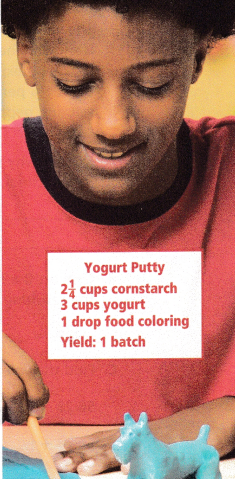
C. What is the maximum whole number of batches Jordan can make with the cornstarch? Explain. _____________________ _____________________ _____________________ Answer: The maximum whole number of batches Jordan can make with the cornstarch is 4.
D. How much does the cornstarch for each batch cost? $____ ÷ ___ ≈ ____, which is approximately $ ___ per batch. Answer: The cornstarch for each batch cost is $31 per batch. = $3.89 ÷ \(\frac{1}{8}\) = $3.89 × 8 = $31 per batch
Turn and Tàlk How can you use estimation to check that your answer for the cost per batch is reasonable?

Explanation: Given, The rate of change = -2\(\frac{2}{5}\)% = -2.4% Growth factor = 1 + growth rate Growth factor = 1 – 2.4% = 1 – 0.024 = 0.976 Every year Charise cactus salt and pepper shakers will have their value increased. After 2 years their value will be $56.28 × 0.976 × 0.976 = $56.28 × 0.9525 $53.61 A. Explain why it is useful to convert the percent to a decimal. _____________________ _____________________ Answer: It is simpler to calculate the values and visualize and compare them. Therefore it is useful to convert the percent to a decimal. B. Convert the mixed-number percent to a decimal percent. Then divide the resulting value in the percent by 100. -2\(\frac{2}{5}\)% = ____% = ____ Answer: -2.4% = -2.4 Given, -2\(\frac{2}{5}\)% Now we need to convert them to a decimal percent \(\frac{12}{5}\)% -2.4% Now divide the result by 100 –\(\frac{2.4}{100}\)% –\(\frac{2.4}{100}\) × 100 = -2.4
C. Find the value of the salt and pepper shakers after the first year. 56.28 × (___) = ____ 56.28 + (___) = ____ To the nearest cent, the value after the first year is $ ____ Answer: The value after the first year is $111.209. 56.28 × 0.976 = 54.92 56.28 + 54.92 = 111.209
D. You can use substitution to rewrite the two expressions in Part C as a single expression: 56.28 + [56.28 × (-0.024)]. Use properties of operations to write this expression as a product of two factors, and show that it has the same value as the final answer to Part C. Answer: Given expression: 56.28 + [56.28 × (-0.024)] = -54.92 Now use properties of operations 56.28 + 56. 28 × (-0.024) = -54.92
E. Find the value of the salt and pepper shakers after the second year. Round your answer to the nearest cent. Show your work.
Turn and Talk A student said that you can solve this problem by finding 2\(\frac{2}{5}\)% of $56.28 and then subtracting this amount twice from $56.28. Does this method work? Why or why not? Answer: Yes, the method works.
Explanation: 2\(\frac{2}{5}\)% of $56.28 \(\frac{12}{5}\)% of $56.28 (12 × 56.28) ÷ 5 675.36 ÷ 5 135.072 – (2 × 56.28) = 135.072 – 113.16 = 21.912

D. Explain how you can check your answer for reasonableness. _____________________ _____________________
Check Understanding
Question 1. A block of clay contains twenty 4-ounce portions of clay. A ceramics teacher wants to use the block to make as many spheres of clay as possible, each weighing \(\frac{2}{5}\) pound. How many spheres can the class make? Answer: The class can make 12.5 spheres.
Explanation: Given, A block of clay has 20 4 – ounce portions = 20 × 4 = 80 ÷ 16 = 5 Spheres of clay each weighing = \(\frac{2}{5}\) 5 ÷ \(\frac{2}{5}\) 5 × \(\frac{5}{2}\) \(\frac{25}{2}\) = 12.5
Question 2. A laptop computer costs $356.75 when it is new. The value of the computer is expected to change by -11\(\frac{3}{4}\)% per year. What is the expected value, to the nearest cent, of the computer after 3 years? Is the answer reasonable? Explain. Answer: $245.19
Explanation: Given, The laptop costs = $356.75 Value of the computer is expected to change by -11\(\frac{3}{4}\)% value of change after 3 years The price = 356.75 × (1 – 11.75%) × (1 – 11.75%) × (1 – 11.75%) = 356.75 × 0.8825 × 0.8825 × 0.8825 = $245.19
On Your Own

A. How many hours will it take Luis to reach Wandering Twin Lake? _____________________ Answer: 1.47 hours.
Explanation: Luis takes 6 minutes to hike at an average rate of \(\frac{1}{3}\). Wandering twin lake is 4.9 miles away it takes to get to the place is 4.9 × 18 88.2 minutes In hours this is 88.2 ÷ 60 = 1.47 hours
B. Explain how you know your answer is reasonable. _____________________ Answer:
Question 4. Financial Literacy Mr. Liling bought 10 shares of stock in QJZ Software at the beginning of 2016 for $198.58 per share. The table shows how the value of the stock changed during 2016 and during 2017. A. What was the total value of Mr. Liling’s shares, rounded to the nearest cent, at the end of 2016? _____________________ Answer: The total value at the end of 2016 is 188.85.
Explanation: Given, Mr Liling bought 10 shares At the beginning of 2016 for $198.58 per share. In year 2016 change in stock prize is -4\(\frac{9}{10}\) = –\(\frac{49}{10}\)% = 100 – \(\frac{49}{10}\)% = 100 – 4.9% = 95.1% The total value of Mr. Liling’s shares is $198.58 × 95.1% = 18884.958 ÷ 100 = 188.85
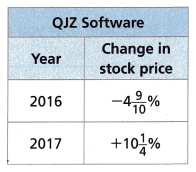
B. What was the total value of Mr. Liling’s shares, rounded to the nearest cent, at the end of 2017? Answer: The total value at the end of 2017 is 218.93. In 2017 change in stock price is 10\(\frac{1}{4}\) = \(\frac{41}{4}\)% = 100 + \(\frac{41}{4}\)% = 100 + 10.25% = 110.25% he total value of Mr. Liling’s shares at the end of 2017 is $198.58 × 110.25% = 21893.445% = 218.93
C. Explain how you know your answers are reasonable. Answer:
Question 5. According to Denise’s recipe, each batch of granola requires 1.75 cups of shelled sunflower seeds. She has 3 bags of shelled sunflower seeds that each contain eleven \(\frac{1}{4}\)-cup servings. What is the maximum number of batches of granola that Denise can make with the sunflower seeds? Answer: 19
Explanation: From the given question find 11\(\frac{1}{4}\) × 3 ÷ 1.75 (\(\frac{45}{4}\) × 3) ÷ 1.75 (\(\frac{45}{4}\) × 3) ÷ (175 ÷ 100) (\(\frac{45}{4}\) × 3) ÷ (7 ÷ 4) (\(\frac{45}{4}\) × 3) × (4 × 7) 135 ÷ 7 19
Question 6. In 2016, a maglev train in Japan traveled 1.1 miles in 10\(\frac{4}{5}\) seconds.
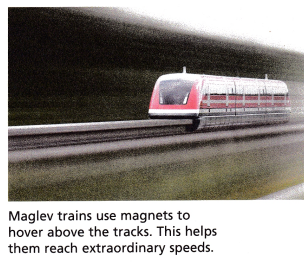
A. Find the speed of the train in miles per hour. Answer: 3.8 miles per hour
Explanation: Given, Distance = 1.1 miles time taken = 10\(\frac{4}{5}\) seconds. = \(\frac{54}{5}\) sec Speed = Distance ÷ time We know, 60 × 60 sec = 1 hr 1 sec = 1 ÷ (60 × 60) \(\frac{54}{5}\) = 1 ÷ (60 × 60) = 1 ÷ (60 × 60) × \(\frac{54}{5}\) = 0.003 hr Speed = 1.1 ÷ (0.003) = 366. 67 miles per hour
B. How can you use estimation to show that your answer is reasonable? Answer: The estimation for the speed is 367 miles per hour. By estimating an approximate answer and it doesnot exceed the original numbers.
Question 7. Brad is using the recipe shown to make trail mix for his hiking club. He buys two 20-ounce canisters of raisins for $4.31 each. A canister holds 17 servings of raisins. Each serving is \(\frac{1}{4}\) cup. A. If Brad only wants to make whole batches of trail mix, what is the maximum number of batches he can make using the raisins? Answer:
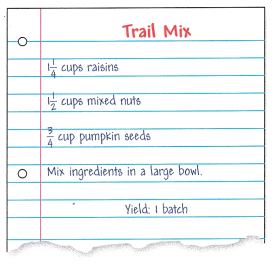
B. Use your answer from Part A to find the cost of the raisins per batch of trail mix. Round your answer to the nearest cent. Answer:
Question 8. The percent error of a measurement tells how close the measurement is to the actual value. Dani ran four times around the track, a total distance of 1,600 meters. Her GPS watch recorded the distance as 1,592 meters. A. To find the percent error, first find the absolute value of the difference between the distance recorded on Dani’s watch and the actual distance. Answer:
B. Now express the difference from Part A as a percent of the actual value. This is the percent error. Answer:
Question 9. A student identified the volume of a solution to be 13 milliliters. The true volume was 12.5 milliliters. What is the percent error of the measurement? Use the definition of percent error in Problem 8. Answer:
Question 10. Gianna is taking a walking tour in her city. The entire tour is 10\(\frac{1}{10}\) kilometers long. According to an app on her phone, Gianna’s average walking rate is 1.6 meters per second.
A. What is Gianna’s average walking rate in kilometers per hour? _____________________ Answer:
B. About how long will it take Gianna to complete the walking tour? Express your answer in hours and minutes. _____________________ Answer:
C. Construct Arguments Explain how you know your answer is reasonable. _____________________ Answer:
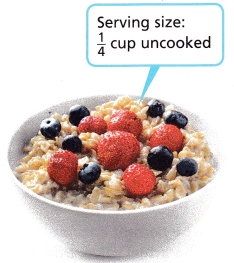
Question 12. Attend to Precision A snail is moving along a path that is 4 meters long. The snail moves at an average rate of 3\(\frac{3}{10}\) inches per minute. A. Find the length of the path to the nearest inch. (Hint: 1 in. ≈ 2.54 cm) Answer: The length of the path is 157 inches.
Explanation: Given, The length of the path = 4 meters 1 meter = 100 cm 4 m = 400 cm also 1 in = 2.54 cm 1 cm = 1 ÷ 2.54 in therefore 400 cm = 400 × (1 ÷ 2.54 inches) = 157.48 = 157 (rounded to the nearest inch).
B. To the nearest minute, how long does it take the snail to reach the end of the path? Answer: 1 minute
Explanation: Given, Speed = 3\(\frac{3}{10}\) inches per minute = \(\frac{33}{10}\) Distance = 4 meters time = Distance ÷ speed = 4 ÷ ( \(\frac{33}{10}\)) = 4 × \(\frac{10}{33}\) = 40 ÷ 33 = 1.2 minute = 1 minute ( Rounded to the nearest minute)
Lesson 6.3 More Practice/Homework
Question 1. Math on the Spot Sophia uses 3\(\frac{3}{4}\) cups of flour for each cake she makes. She has a 10-pound bag of flour that cost $8.79 and contains 152 quarter-cup servings. A. How many cakes can Sophia make with this flour? _____________________ Answer:
B. Use your answer from Part A to find the cost of the flour for each cake. Round your answer to the nearest cent. _____________________ Answer:
Question 2. Use Tools A bobsled team is practicing runs on a track. Their first run takes 4.85 minutes. On each of the next two runs, the team’s time changes by -5\(\frac{1}{2}\)% compared to the previous time. A. What was the team’s time, rounded to the nearest hundredth of a minute on their final run? _____________________ Answer:
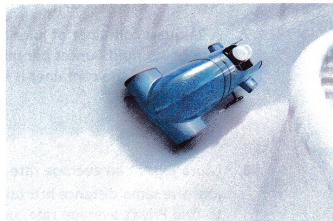
B. Explain how you can check your answer for reasonableness. _____________________ Answer:
Question 3. Use Tools Calvin maintains a 55-gallon artificial pond. He fills the pond with a hose at an average rate of 9\(\frac{3}{16}\) quarts per minute. Answer: Given, 1 gallon = 4 quarts Calvin maintains = 55 gallon artificial pond. Average rate = 9\(\frac{3}{16}\) quarts per minute. = (55 × 4) ÷ 9\(\frac{3}{16}\) = 220 ÷ \(\frac{147}{16}\) = 220 × \(\frac{16}{147}\) = 23.946 minutes = 23.9 minutes.
A. How long, to the nearest tenth of a minute, does it take to fill the pond? Answer: 23.9 minutes.
Explanation: It took 23.9 minutes to fill the pond.
B. Explain how you can check your answer for reasonableness. Answer: Now we will check the reasons = 23.9 × 9\(\frac{3}{16}\) = (23.9 × 3) × \(\frac{16}{147}\) = 219.6 quarts = 219.6 ÷ 4 = 54.9 = 55 gallons
Question 4. Use Tools Kayla bikes for 2.25 hours at an average rate of 10\(\frac{1}{2}\) miles per hour. Talisha bikes the same distance at an average rate of 12\(\frac{2}{5}\) miles per hour. How long does Talisha take to complete the ride? Answer: 1.9 hours
Explanation: Given, The distance = 2.25 × 10\(\frac{1}{2}\) = 2.25 × \(\frac{21}{2}\) = (2.25 × 21) ÷ 2 = 47.5 ÷ 2 = 23.625 Speed = 12\(\frac{2}{5}\) = \(\frac{62}{5}\) time = Distance ÷ speed = 23.625 ÷ (\(\frac{62}{5}\)) = 23.625 × \(\frac{5}{62}\) = (23.625 × 5) ÷ 62 = 118.125 ÷ 62 = 1.9 hours.
Question 5. A new mobile device has a value of $256.25. Its value changes by -22\(\frac{1}{2}\)% each year. What is the value of the phone after two years? A. $140.93 B. $198.59 C. $153.91 D. $57.66 Answer: The value of the phone after two years is $153.91. Given, New mobile device value = $256.25 Value changes by -22\(\frac{1}{2}\)% = –\(\frac{45}{2}\)% Find the value of phine after two years For first year The value of change is 100 – \(\frac{45}{2}\) \(\frac{45}{2}\) = 22.5 100 – 22.5 = 77.5% The value of change for second year is (77.5 × 100 – \(\frac{45}{2}\))% = (77.5 × 77.5)% = 6006.25% = (6006.25 ÷ 10000)× $256.25 = 0.600625 × $256.25 = $153.91
Question 6. Khalid has 2 bags of cornmeal that each contain 25 servings. One serving is \(\frac{3}{4}\) cup. Khalid is making muffins that require 2.5 cups of cornmeal per batch. What is the maximum number of batches of muffins that Khalid can make using the cornmeal? A. 7 B. 15 C. 18 D. 37 Answer:
Question 7. A 2\(\frac{1}{2}\)-quart container of juice develops a leak and loses juice at an average rate of 3.3 fluid ounces per minute. Which is the best estimate of the time it takes until the container is empty? A. 0.75 minute B. 8 minutes C. 24 minutes D. 80 minutes Answer: 0.75 minute
Explanation: Average rate = 3.3 fluid ounces per minute Distance = 2\(\frac{1}{2}\) = \(\frac{5}{2}\) Speed = distance ÷ time 3.3 = \(\frac{5}{2}\) ÷ time time = \(\frac{5}{2}\) ÷ 3.3 = 5 ÷ (3.3 × 2) = 5 ÷ 6.6 = 0.75 minute
Explanation: Given, Average speed rate = 5.6 miles per hour Time = 2\(\frac{1}{10}\) hours = \(\frac{21}{10}\) Priya jogs = 1\(\frac{3}{5}\) = \(\frac{8}{5}\) 5.6 × \(\frac{21}{10}\) × \(\frac{8}{5}\)
Spiral Review
Question 9. Nicolas and Jerome are scuba diving. Nicolas is at an elevation of -25 feet compared to the surface of the water. Jerome is at an elevation of -32 feet. Which diver is closer to the surface of the water? How much closer is he compared to the other diver? Answer: Nicolas is closer to the surface as he is 7 feet closer to the surface than Jerome.
Explanation: Therefore Nicolas is closer to the surface. Nicolas is at an elevation of -25 feet. Jerome is at an elevation of -32 feet. = -25 – (-32) = -7 feet.
Question 10. The temperature at noon on a winter day was 2 °F. By 6 p.m., the temperature had dropped to -9 °F. Write a subtraction expression you can use to find the number of degrees the temperature dropped. Then evaluate the expression. Answer: The expression would be 2 – (-9).
Explanation: We to find the number of degrees the temperature has changed by using the given equation Starting temperature – ending temperature Given, Starting temperature = 2 °F Current temperature = -9 °F Now the equation becomes = 2 – (-9)

Leave a Comment Cancel Reply
You must be logged in to post a comment.

COMMENTS
For a fruit salad recipe, Jenna combined. 3 _ cup of raisins, 7. 8. _ cup of oranges, and 3 _. 8 4 cup of apples. About how many cups of fruit are in. Practice and Homework. Lesson 6.3. COMMON CORE STANDARD—5.NF.A.2.
roblem Solving . Title: Go Math! Practice Book (TE), G5 Created Date: 1/11/2017 2:48:24 PM
Practice and Homework Lesson 6.3 15. WRITE Math Explain using words or drawings how to write 6_ 9 in simplest form. 6 __ 10 = 6 ÷ 2 ___ 10 ÷ 2 = 3 _ 5. Personal Math Trainer FOR MORE PRACTICE GO TO THE 344 ... Lesson Check (4.NF.A.1) Created Date: 3/20/2015 12:24:51 PM ...
Practice LESSON 6.3 For use with pages 371—379 List all pairs of congruent angles for the figures. Then wr- the corresponding sides in a statement of proportionali ... Chapter 6 Practice Workbook 111 20. 21. 22. What is the scale factor of the pool to the fence? What is the length of the pool?
Go Math! Practice Book (TE), G5. COMMON CORE STANDARDS CC.5.NF.1, CC.5.NF.2 Name Chapter 6 Extra Practice Lessons 6.1-6.2 use fraction strips to find the sum or difference. Write your answer in simplest form. 10 Lesson 6.3 Estimate the sum or difference. 5 10 17 18 Possible estimates are given. 12 8 10 12 Lesson 6.4 use a common denominator to ...
Practice and Homework Lesson 6.3 COMMON CORE STANDARD—3.OA.A.2 Represent and solve problems involving multiplication and division. Chapter 6 317 Draw counters on your MathBoard. Then circle equal groups. Complete the table. Counters Number of Equal Groups Number in Each Group 1. 24 3 8 2. 35 7 3. 30 5 4. 16 4 5. 12 6 6. 36 9 7. 18 3 8. In his ...
This video covers Lesson 6.3 Estimate Fraction Sums and Differences on pages 261-264 of the 5th grade GO Math textbook.
This lesson uses the benchmarks 0, 1/2, and 1 to help us estimate fraction sums and differences.
This math video covers the estimating fraction sums and differences. One important strategy introduced in the video is the use of benchmark fractions for rou...
6.3: Homework. Submit homework separately from this workbook and staple all pages together. (One staple for the entire submission of all the unit homework) Start a new module on the front side of a new page and write the module number on the top center of the page. Answers without supporting work will receive no credit.
Lesson 6.3 Practice Quiz. Get a hint. Jesus passed out on the cross and in the tomb He was resuscitated is the ___ theory. Click the card to flip 👆. Swoon. Click the card to flip 👆. 1 / 25.
Lesson 5.6 COMMON CORE STANDARDS CC.5.NBT.2, CC.5.NBT.7 Perform operations with multi-digit whole numbers and with decimals to hundredths. 3. 6. 9. 24 9 4.7 4. 0.4)ŠÃ Multiply both 4 0.4 and 8.4 by 10 to make the divisor a whole number. Then divide. 14 6.3 - 10.81 0.7 - 2.3 1.52 - 1.9 36 0.8 Problem Solving REAL WORLD 10.
Texas Go Math Grade 5 Lesson 6.3 Homework and Practice Answer Key. Find the product. Write the product in the simplest form. Question 1. \(\frac{3}{7}\) × 4 = _____ ... Go Math Grade 5 Lesson 6.3 Homework Answer Key Question 23. Multi-Step Meredith's class has 21 students. Meredith rides the bus home with \(\frac{2}{3}\) of the students in ...
CPM Education Program proudly works to offer more and better math education to more students.
1.7 Puzzles for Homework. Chapter 2: Linear Equations. 2.1 Elementary Linear Equations. 2.2 Solving Linear Equations. 2.3 Intermediate Linear Equations. 2.4 Fractional Linear Equations. 2.5 Absolute Value Equations. 2.6 Working With Formulas. 2.7 Variation Word Problems. 2.8 The Mystery X Puzzle.
From Open Up Resources, https://openupresources.org/ Grade 6 Unit 3 Lesson 6
How many ounces of food will each cat get? (Lesson 1.9) 3 ounces 4 ounces 6 ounces 8 ounces P68 2. 4. 6. Anton rode his mountain bike three days in a row. He biked 12.1 miles on the first day, 13.4 miles on the second day, and 17.9 miles on the third day.
Lesson Prove Triangles Similar by AA, continued 22. You are given that DE} is a midsegment of n ABC. Then DE} i AC} by the Midsegment Thm., which means that ∠ A > ∠ BDE and ∠ C > ∠ BED by the Corr. Angles Post. Therefore, n ABC , nDBE by the AA Similarity Post. 23. 37 1} 3 ft Practice Level B 1. nDEF 2. DE, BC, FD 3. ∠E 4. x, y 5. 9 ...
Spiral Review. (5.NBT.A.1, 5.NBT.A.2, 5.NBT.B.6) 3. In the number 2,145,857, how does the digit 5 in the thousands place compare to the digit 5 in the tens place? 5. Carmen works at a pet store. To feed 8 cats, she empties four 6-ounce cans of cat food into a large bowl. Carmen divides the food equally among the cats.
Lesson 6.3 More Practice/Homework. Use Rate Reasoning to Convert Between Measurement Systems. Question 1. Reason An elevator can hold at most 2,500 pounds. If 10 adults with an average mass of 80 kilograms each get on the elevator, can the elevator carry them? Show your work. Answer: Yes, the elevator can carry them. Explanation:
Problem Solving REAL WORLD. Problem Solving REAL WORLD. Title. Go Math! Practice Book (TE), G5. Created Date. 1/10/2017 1:36:01 PM.
Lesson 6.3 More Practice/Homework. Question 1. Math on the Spot Sophia uses 3\(\frac{3}{4}\) cups of flour for each cake she makes. She has a 10-pound bag of flour that cost $8.79 and contains 152 quarter-cup servings. A. How many cakes can Sophia make with this flour? _____ Answer: B. Use your answer from Part A to find the cost of the flour ...